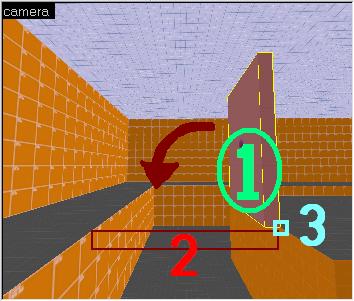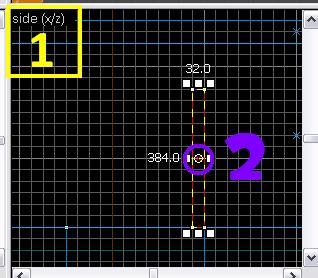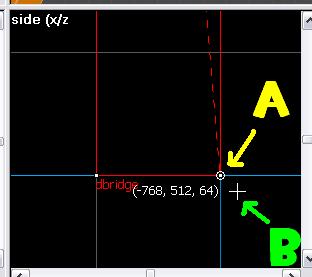func_door_rotating
| CRotDoor |
func_door_rotating is a brush entity available in all ![]() Source games. It is a rotating brush that can be "opened" by players or NPCs.
Source games. It is a rotating brush that can be "opened" by players or NPCs.
Notes
Axis
The func_door_rotating entity can only rotate around either the x, y or z axis and no combination of the two other than x and y. By default, the entity is set to rotate on the Z-axis and can be changed through altering the flags section of the object properties.
Setting the Origin
The point of rotation can be changed through the alteration of the entities origin. The origin sets which point on the plane of movement the object will rotate through, think of it as a hinge for a door. With the show helpers option enabled in Hammer, the origin will appear as a small white circle in the center of the entity that can be dragged to a new location.
Example
Bugs
- Sometimes there are situations when for unknown reason lighting just doesn't show correctly on door model and all is "black" and you can't do anything with it (move brushes around the door to avoid clipping, check material model shader of it (it's fine), disable shadows, etc). There is a simple and effective way to fix it: just select all your level and move it! Vrad sometimes can make mistakes like this on static and dynamic objects and when you adjust position of your whole level, it will change this calculations and coordinates for lighting.
- If the speed of the door is changed by the SetSpeed input while it is opening or closing, the speed remains the same until the door is opened or closed again.
Keyvalues
- Name (targetname) <string>
- The name that other entities refer to this entity by, via Inputs/Outputs or other keyvalues (e.g.
parentnameortarget).
Also displayed in Hammer's 2D views and Entity Report. - See also: Generic Keyvalues, Inputs and Outputs available to all entities
- Distance (distance) <float>
- Degrees the door should rotate. It will rotate away from the player if +used. Otherwise, direction is determined by if the value is negative or positive.
- Solid Type (solidbsp) <boolean>
- How to calculate collisions. Set this to BSP if the player seems to rotate oddly relative to the surface.
BaseDoor:
- Linked Door (chainstodoor) <targetname> !FGD
- Passes the door's +use inputs and touch events onto a different door, so it also is activated.
- Block Filter Name (filtername) <targetname> (only in

 )
) - Filter to use to determine entities that can block the door. Players can always block the door.
- Speed (speed) <float>
- Speed that the door moves, in units (sliding door) or degrees (rotating door) per second.
- Start Sound (noise1) <sound>
- Sound to play when the door starts opening. Also plays when door starts closing if startclosesound is absent.
- Stop Sound (noise2) <sound>
- Sound to play when the door stops opening. Also plays when door stops closing if closesound is absent.
- Start Close Sound (startclosesound) <sound>
- Sound to play when the door starts closing.
- Stop Close Sound (closesound) <sound>
- Sound to play when the door stops closing.
- Delay Before Reset (wait) <float>
- Time until the door returns to the closed position. A value of -1 means the door never auto-closes.
- Lip (lip) <float>
- When the door opens, it will move its full length minus this many units. Negative values will make the door move that many more than its length.
- Blocking Damage (dmg) <float>
- Amount of damage done to entities that block the movement of this door, per frame.
 Bug:Normally a door will damage things blocking it, however if the player is teleported by a trigger_teleport while using noclip, they will not be damaged.
Bug:Normally a door will damage things blocking it, however if the player is teleported by a trigger_teleport while using noclip, they will not be damaged.
- Force Closed (forceclosed) <boolean>
- Makes the door close no matter what. Useful for doors that have to close even if the player tries to block them with objects.
- Ignore Debris (ignoredebris) <boolean>
- Changes the door's collision group to
COLLISION_GROUP_INTERACTIVE, which ignores debris objects. Not compatible with the Non-solid to Player spawnflag as it also sets a collision group.
Health (shoot open) (health) <integer>
- FGD leftover from
 Quake.
Quake.
In Quake, if this was set, the door would open when it took this much damage. A shoot-to-open door can be created using func_button or func_rot_button instead.
Message If Triggered (message) <string>
- FGD leftover from GoldSrc.
In Quake and
Quake and  GoldSrc, if this was set, a message would appear on the the player's hud when the door is locked and they attempt to open the door. Nonfunctional in most
GoldSrc, if this was set, a message would appear on the the player's hud when the door is locked and they attempt to open the door. Nonfunctional in most  Source games; can be emulated by calling an env_message with the door's
Source games; can be emulated by calling an env_message with the door's OnLockedUseoutput.
- Locked Sound (locked_sound) <sound>
- Sound played when the player tries to open the door, and fails because it's locked.
- Unlocked Sound (unlocked_sound) <sound>
- Sound played when door is unlocked.
- Spawn Position (spawnpos) <integer choices>
- State the door should begin in.
- 0: Closed
- 1: Open
- Locked Sentence Group (locked_sentence) <byte choices>
- Intercom voiceline for when the player tries to use the door, but it's locked.
Sentence Groups - None (Default)
- Gen. Access Denied (NA)
- Security Lockout (ND)
- Blast Door (NF)
- Fire Door (NFIRE)
- Chemical Door (NCHEM)
- Radiation Door (NRAD)
- Gen. Containment (NCON)
- Maintenance Door (NH)
- Broken Shut Door (NG)
- Unlocked Sentence Group (unlocked_sentence) <byte choices>
- Intercom voiceline for when the door is unlocked.
Sentence Groups - None (Default)
- Gen. Access Granted (EA)
- Security Disengaged (ED)
- Blast Door (EF)
- Fire Door (EFIRE)
- Chemical Door (ECHEM)
- Radiation Door (ERAD)
- Gen. Containment (ECON)
- Maintenance Door (EH)
- Loop Moving Sound? (loopmovesound) <boolean>
- Makes the door's Start Sound loop until the door finishes moving.
 Bug:If an already-looping sound is played with this enabled, it can continue forever. Further attempts to open or close the door will only add another looping sample to the noise.
Bug:If an already-looping sound is played with this enabled, it can continue forever. Further attempts to open or close the door will only add another looping sample to the noise.
Flags
- Reverse Dir : [2]
- This door opens in the opposite direction
- One-way : [16]
- This door only opens in one direction.
- X Axis : [64]
- This door rotates on the X axis.
- Y Axis : [128]
- This door rotates on the Y axis.
BaseDoor:
Starts Open : [1]
- Deprecated.
Door behaves more like the doors in Half-Life. Some outputs don't work.
Half-Life. Some outputs don't work.
- Non-solid to Player : [4]
- Sets the collision group to
COLLISION_GROUP_PASSABLE_DOOR, so the player cannot collide with it while other things can. This is not compatible with Ignore Debris as that also sets a collision group.
- Passable : [8]
- This door is solid to nothing at all.
- Toggle : [32]
- Inputs are interpreted as to open if the door is closed and to close if open, instead of the default behavior where inputs are always interpreted as to open. This sets the delay before reset to -1 (overriding
wait), i.e., the door will never reset.
- Use Opens : [256]
- NPCs Can't : [512]
- NPCs can't open this door.
- Touch Opens : [1024]
- When a player or NPC touches the door, it will count as an attempt to open it.
 Bug:The door will play it's Locked Sound when touched, even if Touch Opens is disabled
Bug:The door will play it's Locked Sound when touched, even if Touch Opens is disabled
- Starts locked : [2048]
- This door spawns locked and cannot be opened by the player or NPCs (but buttons can still trigger it).
- Door Silent : [4096]
- This door makes no noise.
- New Use rules : [65536] !FGD
- Door can only be used if it's not moving, is closing, or when it's open.
Inputs
Door:
- Open
- Opens door.
- Close
- Closes door.
- Toggle
- Opens door if closed, closes door if opened.
- Lock
- Prevent door from opening, but can still close.
- Unlock
- Allow door to operate as normal.
- SetSpeed <float>
- Sets Speed.
Outputs
BaseDoor:
- OnClose
- !activator = the door itself if closed by player, if closed by Close input the activator of the input is used
!caller = this entity
Fired when the door starts to close.
- OnOpen
- !activator = the door itself if opened by player, if opened by Open or OpenAwayFrom input the activator of the input is used
!caller = this entity
Fired when the door starts to open.
- OnFullyClosed
- !activator = player that closed the door
!caller = this entity
Fired when the door finishes closing. Reversed if Start Open flag is set.
- OnFullyOpen
- !activator = !caller = this entity
Fired when the door finishes opening. Reversed if Start Open flag is set.
- OnBlockedClosing
- !activator = entity that blocks the door
!caller = this entity
Fired when the door has been blocked from closing.
- OnBlockedOpening
- !activator = entity that blocks the door
!caller = this entity
Fired when the door has been blocked from opening.
- OnUnblockedClosing
- !activator = !caller = this entity
Fired when the door is no longer blocked from closing.
- OnUnblockedOpening
- !activator = !caller = this entity
Fired when the door is no longer blocked from opening.
- OnLockedUse
- !activator = caller = the player pressing use
Fired when the player tries to open the door but fails because it is locked.
See also
- func_rotating
- func_door (sliding instead of rotating)
- Door creation
- WiseDoor - example use and illustration of doors.
- WiseDoorBreak - Breakable doors



